中考语篇填空中动词适当形式变换规则(共73张PPT)
文档属性
| 名称 | 中考语篇填空中动词适当形式变换规则(共73张PPT) | 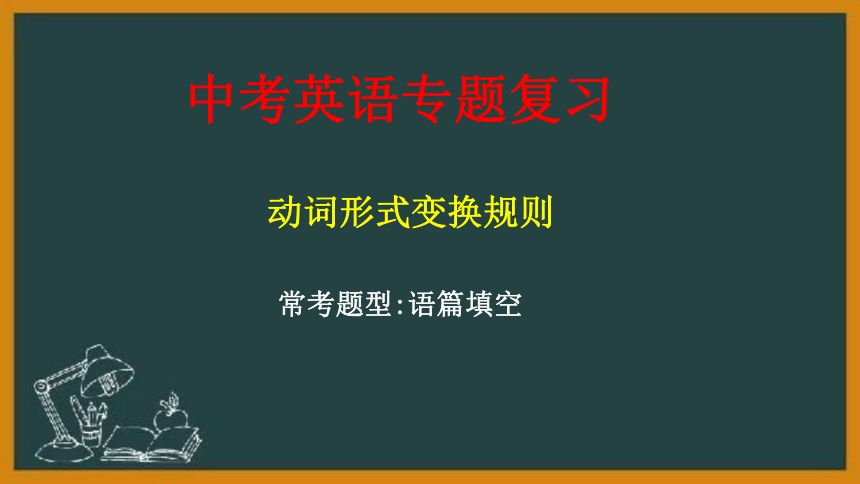 | |
| 格式 | zip | ||
| 文件大小 | 325.3KB | ||
| 资源类型 | 教案 | ||
| 版本资源 | 人教新目标(Go for it)版 | ||
| 科目 | 英语 | ||
| 更新时间 | 2023-01-09 10:40:06 | ||
图片预览

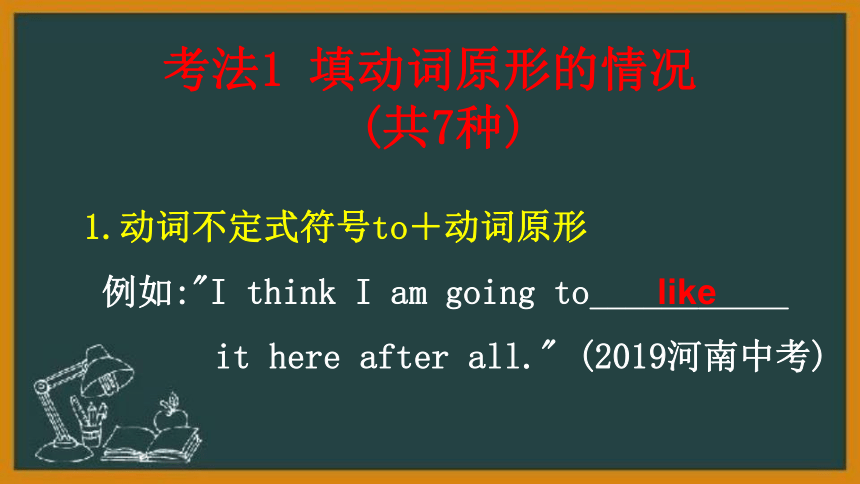
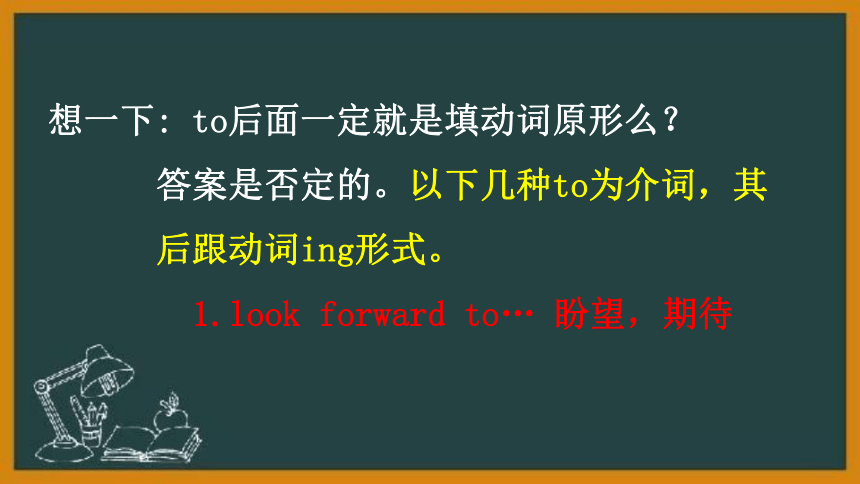
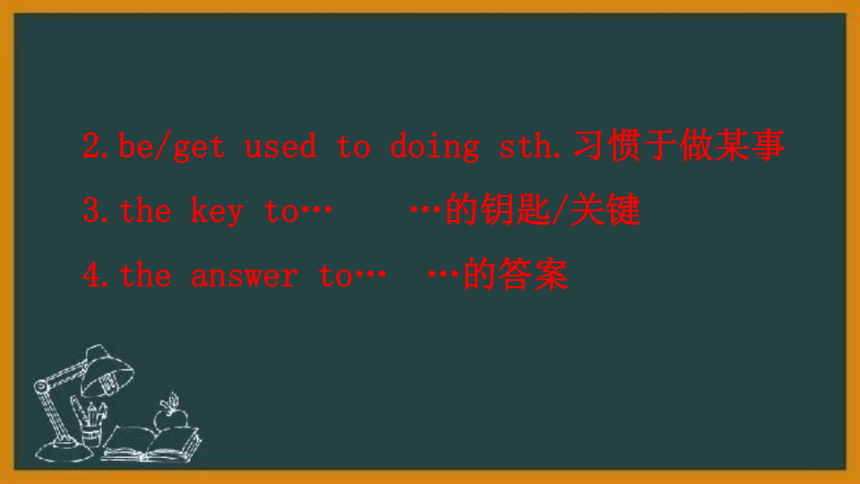
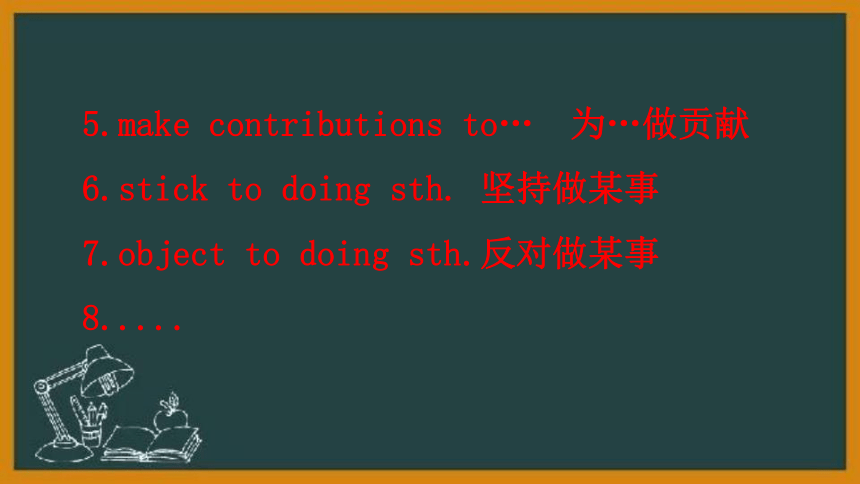


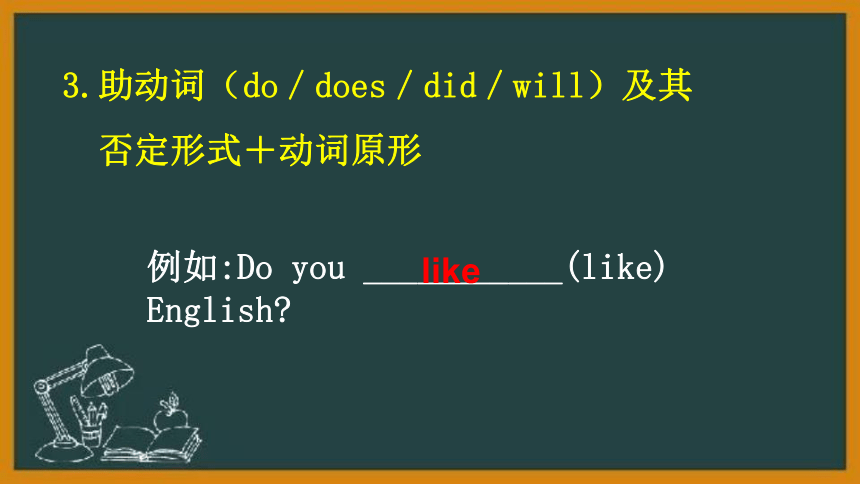
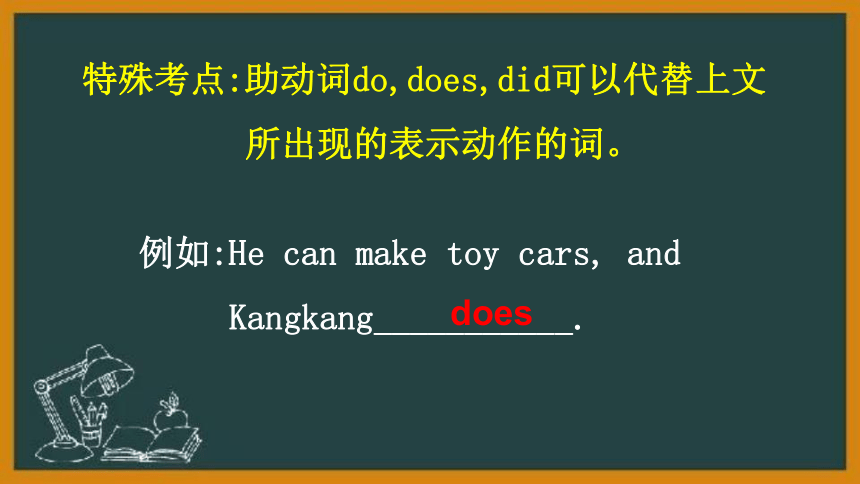
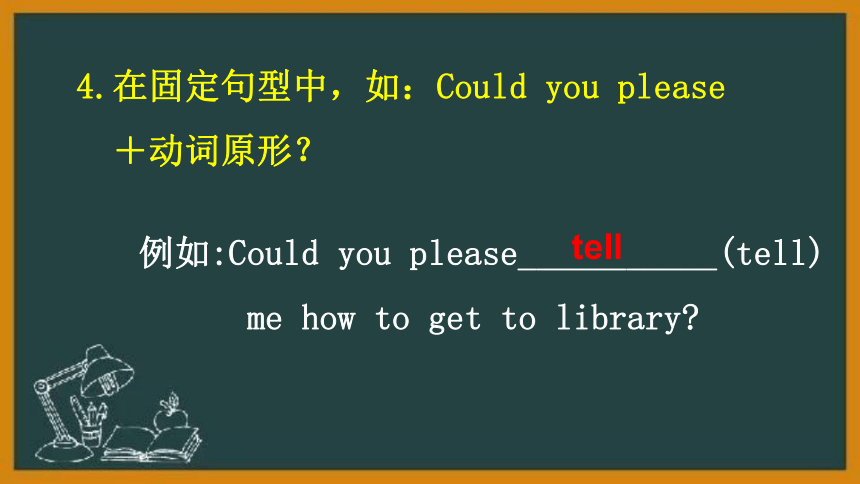
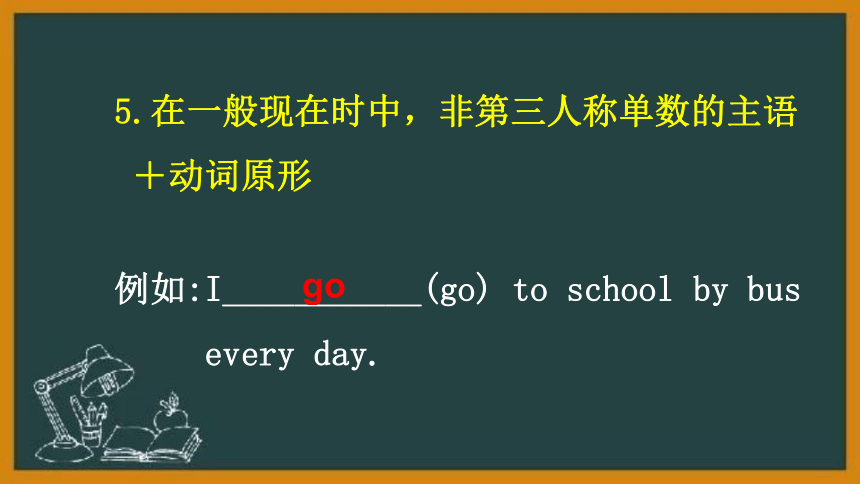

文档简介
(共73张PPT)
中考英语专题复习
动词形式变换规则
常考题型:语篇填空
1.动词不定式符号to+动词原形
例如:"I think I am going to___________
it here after all." (2019河南中考)
考法1 填动词原形的情况
(共7种)
like
想一下: to后面一定就是填动词原形么?
答案是否定的。以下几种to为介词,其
后跟动词ing形式。
1.look forward to… 盼望,期待
2.be/get used to doing sth.习惯于做某事
3.the key to… …的钥匙/关键
4.the answer to… …的答案
5.make contributions to… 为…做贡献
6.stick to doing sth. 坚持做某事
7.object to doing sth.反对做某事
8.....
例如:to为介词的考法
He is used to___________(get) up
early.
getting
2.情态动词及其否定形式+动词原形
例如:I can study hard and___________
(go) to a good school.
go
3.助动词(do/does/did/will)及其
否定形式+动词原形
例如:Do you ___________(like) English
like
例如:He can make toy cars, and
Kangkang___________.
特殊考点:助动词do,does,did可以代替上文
所出现的表示动作的词。
does
4.在固定句型中,如:Could you please
+动词原形?
例如:Could you please___________(tell)
me how to get to library
tell
5.在一般现在时中,非第三人称单数的主语
+动词原形
例如:I___________(go) to school by bus
every day.
go
6.使役动词(let/make/have等)+宾
语+动词原形
例如:That made me___________(feel)
very happy.
feel
温馨提示
在被动语态中,使役动词后需加to.
例如:make sb. do sth.让某人做某事
(主动语态)
sb. be made to do sth.某人被迫做某事
(被动语态)
有关使役动词被动语态结构的考点:
I am made___________learn to sing.
to
7.祈使句以动词原形开头,且后跟动词原形
例如:Let's (play) basketball.
play
考法2 词形转换
一.变第三人称单数的情况
(共5种)
1.主语为第三人称单数he/she/it时,后面
的动词需用三单形式
例如:她非常喜欢英语。
She likes English very much.
2.(a/an/one/this/that+)可数名词
单数/不可数名词作主语时,谓语动词需
用三单形式.
例如:这只兔子跑的很快。
This dog runs very fast.
3.指示代词it/this/that作主语时 ,谓语
动词用三单形式。
例如:这是一本书.
This is a book
4.复合不定代词something/everything/
nobody等作主语时,谓语动词用三单形式。
例如:所有人都喜欢吃苹果。
Everyone likes eating appled.
5.单个人名、地名或是称呼作主语时,
谓语动词用三单形式。
例如:北京是一个好地方。
Beijing is a good place.
补充: 动词第三人称单数的变化规则:
1.一般情况下,在动词原形后直接加-s.
例如:
work→works
read →reads
那么,动词三单形式是如何构成的呢?
2. 以s,x,ch,sh,o,z结尾的动词,后加-es .
例如:
watch → watches
go → goes
3. 以辅音字母加y结尾的动词,应将
y变为i,再加-es
例如 :
fly→flies
study→studies
二.变过去式的情况
(共5种)
1.句中有明显的表示过去的时间标志词
(如:yesterday,last year等)
例如:昨天下雨了。
It (rain) yesterday.
rained
2.主从句时态一致,当主句为一般过去时,从
句通常也用过去的某种时态
例如:老师说昨天她去北京了。
The teacher said she (go)
to Beijing yesterday.
went
3.并列连词(and)连接两个并列动词或并列句
例如:他回家拿回了他的钥匙。
He went home and (take)
his keys.
took
4.根据上下文语境和时态判断
若上文使用了过去式,则下文也用过去式。
5.考查can表能力的过去式could的用法
例如:Could you please help me
那么,动词如何变过去式呢?规则变化如下:
1. 一般在动词原形后直接加-ed
例如:help→helped
play→played
2. 以不发音的字母e结尾的动词后只加-d
例如: like→liked
close→closed
3. 以辅音字母加y结尾的动词,应将y变为
i,再加-ed
例如: study→studied
carry→carried
4. 以重读闭音节结尾且末尾只有一个辅音字
母的动词,双写此辅音字母,再加-ed
例如: stop→stopped
control→controlled
三.变过去分词的情况
(共3种)
1.用于“现在/过去完成时(have/
has/had+done)”的结构中
例如:我已经教了五年学了。
I have (teach) here for
five years.
taught
2.用于“各种时态的被动语态(am/is/
are/was/were/will be+done)”的
结构中
例如:这棵树将被砍倒。This tree will
be (cut) down.
cut
3.在固定的句型或短语中,如:It's
said/reported that...
例如:It's said that there was an
angel in our city.
温馨提示:
动词的过去分词规则变化
同过去式一样。
四.变现在分词的情况
(共2种)
1.用于“现在/过去进行时(am/is/are/
was/were+doing)”结构中
例如:Kangkang was (watch)
TV at this time yesterday.
watching
2.用于while引导的时间状语从句中
例如:Mary is watching TV while I am
(do) my homework.
doing
1. 一般情况下,在动词原形后直接加-ing
例如: walk→walking
laugh→laughing
补充:现在分词与动名词变化规则
2. 以不发音的字母e结尾的动词去e,
再加-ing
write→writing
move→moving
3. 以重读闭音节结尾且末尾只有一个辅音字
母的动词,双写此辅音字母,再加-ing
例如:put→putting
begin→beginning
sit→sitting
4. 少数以ie结尾的动词,变ie为y,再加-ing
例如:die→dying
lie→lying
考点3 词性转换
一、动词变名词的情况
(共 4 种)
1.位于冠词a,an,the后
例: 这是一个很好的选择。
This is a good (choose).
choice
2.句子缺少主语,通常位于句首
例: 眼见为实。
(see) is believing.
Seeing
3.句子缺少宾语,谓语动词+名词或者
位于介词之后
例:我们让他成为了领导。
We made him a (lead).
leader
4.位于形容词或形容词性物主代词之后
例:他们说昨天这有一场精彩的演讲。
They said there was a wonderful
(speak) yesterday.
speech
“动词变名词”的常见规则如下:
①动词+-er(-or/-r)
常考单词: drive→driver
work→worker
特殊补充
dance→dancer
design→designer
report→reporter
sing→singer
teach→teacher act→actor invent→inventor
write→writer
②动词+-ing
常考单词:swim→swimming
begin→beginning
③动词+-ment
常考单词:achieve→achievement
agree→agreement
develop→development
improve→improvement
④动词+(t)ion或去e+(t)ion
常考单词:celebrate→celebration
collect→collection
connect→connection
direct→direction
educate→education
introduce→introduction
invent→invention
pollute→pollution
⑤其他特殊形式
advise→advice choose→choice
decide→decision die→death
fail→failure serve→service
二、动词变形容词的情况
(共 5 种)
1.在be动词或感官动词之后作表语
例:那是我感到很开心。
That made me feel happy.
2.位于名词前作定语
例:Kangkang是一个帅气的男孩儿。
Kangkang is a handsome boy.
3.形容词+and/or+形容词
例:我认为那个男孩又高又瘦。
I think that boy is tall and thin.
4.在“make/let/find+sb./sth.+adj.
结构中
例:那使我非常开心。
That made me feel very happy.
5.在固定搭配或句型中,如:be interested
in, It is+adj.+of/for sb. to do sth.等
例:学习英语对我们来说是有用的。
It is useful for us to study English.
“动词变形容词”的常见规则如下:
①动词+-ful
常考单词: use→useful
care→careful
特殊补充
help→helpful
regret→regretful
thank→thankful
cheer→cheerful
②动词+-d/-ed/-ing
常考单词:
annoy→annoyed/annoying
bore→bored/boring
excite→excited/exciting
interest→interested/interesting
please→pleased/pleasing
relax→relaxed/relaxing
③词尾变y为i,再加-ed
常考单词:
marry→married
satisfy→satisfied
terrify→terrified
worry→worried
④动词+-able
常考单词: accept→acceptable
enjoy→enjoyable
change→changeable
Thanks for your listening
中考英语专题复习
动词形式变换规则
常考题型:语篇填空
1.动词不定式符号to+动词原形
例如:"I think I am going to___________
it here after all." (2019河南中考)
考法1 填动词原形的情况
(共7种)
like
想一下: to后面一定就是填动词原形么?
答案是否定的。以下几种to为介词,其
后跟动词ing形式。
1.look forward to… 盼望,期待
2.be/get used to doing sth.习惯于做某事
3.the key to… …的钥匙/关键
4.the answer to… …的答案
5.make contributions to… 为…做贡献
6.stick to doing sth. 坚持做某事
7.object to doing sth.反对做某事
8.....
例如:to为介词的考法
He is used to___________(get) up
early.
getting
2.情态动词及其否定形式+动词原形
例如:I can study hard and___________
(go) to a good school.
go
3.助动词(do/does/did/will)及其
否定形式+动词原形
例如:Do you ___________(like) English
like
例如:He can make toy cars, and
Kangkang___________.
特殊考点:助动词do,does,did可以代替上文
所出现的表示动作的词。
does
4.在固定句型中,如:Could you please
+动词原形?
例如:Could you please___________(tell)
me how to get to library
tell
5.在一般现在时中,非第三人称单数的主语
+动词原形
例如:I___________(go) to school by bus
every day.
go
6.使役动词(let/make/have等)+宾
语+动词原形
例如:That made me___________(feel)
very happy.
feel
温馨提示
在被动语态中,使役动词后需加to.
例如:make sb. do sth.让某人做某事
(主动语态)
sb. be made to do sth.某人被迫做某事
(被动语态)
有关使役动词被动语态结构的考点:
I am made___________learn to sing.
to
7.祈使句以动词原形开头,且后跟动词原形
例如:Let's (play) basketball.
play
考法2 词形转换
一.变第三人称单数的情况
(共5种)
1.主语为第三人称单数he/she/it时,后面
的动词需用三单形式
例如:她非常喜欢英语。
She likes English very much.
2.(a/an/one/this/that+)可数名词
单数/不可数名词作主语时,谓语动词需
用三单形式.
例如:这只兔子跑的很快。
This dog runs very fast.
3.指示代词it/this/that作主语时 ,谓语
动词用三单形式。
例如:这是一本书.
This is a book
4.复合不定代词something/everything/
nobody等作主语时,谓语动词用三单形式。
例如:所有人都喜欢吃苹果。
Everyone likes eating appled.
5.单个人名、地名或是称呼作主语时,
谓语动词用三单形式。
例如:北京是一个好地方。
Beijing is a good place.
补充: 动词第三人称单数的变化规则:
1.一般情况下,在动词原形后直接加-s.
例如:
work→works
read →reads
那么,动词三单形式是如何构成的呢?
2. 以s,x,ch,sh,o,z结尾的动词,后加-es .
例如:
watch → watches
go → goes
3. 以辅音字母加y结尾的动词,应将
y变为i,再加-es
例如 :
fly→flies
study→studies
二.变过去式的情况
(共5种)
1.句中有明显的表示过去的时间标志词
(如:yesterday,last year等)
例如:昨天下雨了。
It (rain) yesterday.
rained
2.主从句时态一致,当主句为一般过去时,从
句通常也用过去的某种时态
例如:老师说昨天她去北京了。
The teacher said she (go)
to Beijing yesterday.
went
3.并列连词(and)连接两个并列动词或并列句
例如:他回家拿回了他的钥匙。
He went home and (take)
his keys.
took
4.根据上下文语境和时态判断
若上文使用了过去式,则下文也用过去式。
5.考查can表能力的过去式could的用法
例如:Could you please help me
那么,动词如何变过去式呢?规则变化如下:
1. 一般在动词原形后直接加-ed
例如:help→helped
play→played
2. 以不发音的字母e结尾的动词后只加-d
例如: like→liked
close→closed
3. 以辅音字母加y结尾的动词,应将y变为
i,再加-ed
例如: study→studied
carry→carried
4. 以重读闭音节结尾且末尾只有一个辅音字
母的动词,双写此辅音字母,再加-ed
例如: stop→stopped
control→controlled
三.变过去分词的情况
(共3种)
1.用于“现在/过去完成时(have/
has/had+done)”的结构中
例如:我已经教了五年学了。
I have (teach) here for
five years.
taught
2.用于“各种时态的被动语态(am/is/
are/was/were/will be+done)”的
结构中
例如:这棵树将被砍倒。This tree will
be (cut) down.
cut
3.在固定的句型或短语中,如:It's
said/reported that...
例如:It's said that there was an
angel in our city.
温馨提示:
动词的过去分词规则变化
同过去式一样。
四.变现在分词的情况
(共2种)
1.用于“现在/过去进行时(am/is/are/
was/were+doing)”结构中
例如:Kangkang was (watch)
TV at this time yesterday.
watching
2.用于while引导的时间状语从句中
例如:Mary is watching TV while I am
(do) my homework.
doing
1. 一般情况下,在动词原形后直接加-ing
例如: walk→walking
laugh→laughing
补充:现在分词与动名词变化规则
2. 以不发音的字母e结尾的动词去e,
再加-ing
write→writing
move→moving
3. 以重读闭音节结尾且末尾只有一个辅音字
母的动词,双写此辅音字母,再加-ing
例如:put→putting
begin→beginning
sit→sitting
4. 少数以ie结尾的动词,变ie为y,再加-ing
例如:die→dying
lie→lying
考点3 词性转换
一、动词变名词的情况
(共 4 种)
1.位于冠词a,an,the后
例: 这是一个很好的选择。
This is a good (choose).
choice
2.句子缺少主语,通常位于句首
例: 眼见为实。
(see) is believing.
Seeing
3.句子缺少宾语,谓语动词+名词或者
位于介词之后
例:我们让他成为了领导。
We made him a (lead).
leader
4.位于形容词或形容词性物主代词之后
例:他们说昨天这有一场精彩的演讲。
They said there was a wonderful
(speak) yesterday.
speech
“动词变名词”的常见规则如下:
①动词+-er(-or/-r)
常考单词: drive→driver
work→worker
特殊补充
dance→dancer
design→designer
report→reporter
sing→singer
teach→teacher act→actor invent→inventor
write→writer
②动词+-ing
常考单词:swim→swimming
begin→beginning
③动词+-ment
常考单词:achieve→achievement
agree→agreement
develop→development
improve→improvement
④动词+(t)ion或去e+(t)ion
常考单词:celebrate→celebration
collect→collection
connect→connection
direct→direction
educate→education
introduce→introduction
invent→invention
pollute→pollution
⑤其他特殊形式
advise→advice choose→choice
decide→decision die→death
fail→failure serve→service
二、动词变形容词的情况
(共 5 种)
1.在be动词或感官动词之后作表语
例:那是我感到很开心。
That made me feel happy.
2.位于名词前作定语
例:Kangkang是一个帅气的男孩儿。
Kangkang is a handsome boy.
3.形容词+and/or+形容词
例:我认为那个男孩又高又瘦。
I think that boy is tall and thin.
4.在“make/let/find+sb./sth.+adj.
结构中
例:那使我非常开心。
That made me feel very happy.
5.在固定搭配或句型中,如:be interested
in, It is+adj.+of/for sb. to do sth.等
例:学习英语对我们来说是有用的。
It is useful for us to study English.
“动词变形容词”的常见规则如下:
①动词+-ful
常考单词: use→useful
care→careful
特殊补充
help→helpful
regret→regretful
thank→thankful
cheer→cheerful
②动词+-d/-ed/-ing
常考单词:
annoy→annoyed/annoying
bore→bored/boring
excite→excited/exciting
interest→interested/interesting
please→pleased/pleasing
relax→relaxed/relaxing
③词尾变y为i,再加-ed
常考单词:
marry→married
satisfy→satisfied
terrify→terrified
worry→worried
④动词+-able
常考单词: accept→acceptable
enjoy→enjoyable
change→changeable
Thanks for your listening
同课章节目录
- 词法
- 名词
- 动词和动词短语
- 动词语态
- 动词时态
- 助动词和情态动词
- 非谓语动词
- 冠词
- 代词
- 数词和量词
- 形容词副词及其比较等级
- 介词和介词短语
- 连词和感叹词
- 构词法
- 相似、相近词比较
- 句法
- 陈述句
- 一般疑问句和否定疑问句
- 特殊疑问句及选择疑问句
- 反意疑问句
- 存在句(There be句型)
- 宾语从句
- 定语从句
- 状语从句
- 主谓一致问题
- 简单句
- 并列句
- 复合句
- 主谓一致
- 主、表语从句
- 名词性从句
- 直接引语和间接引语
- 虚拟语气
- 感叹句
- 强调句
- 倒装句
- 祈使句
- 句子的成分
- 句子的分类
- 题型专区
- 单项选择部分
- 易错题
- 完形填空
- 阅读理解
- 词汇练习
- 听说训练
- 句型转换
- 补全对话
- 短文改错
- 翻译
- 书面表达
- 任务型阅读
- 语法填空
- 其他资料
